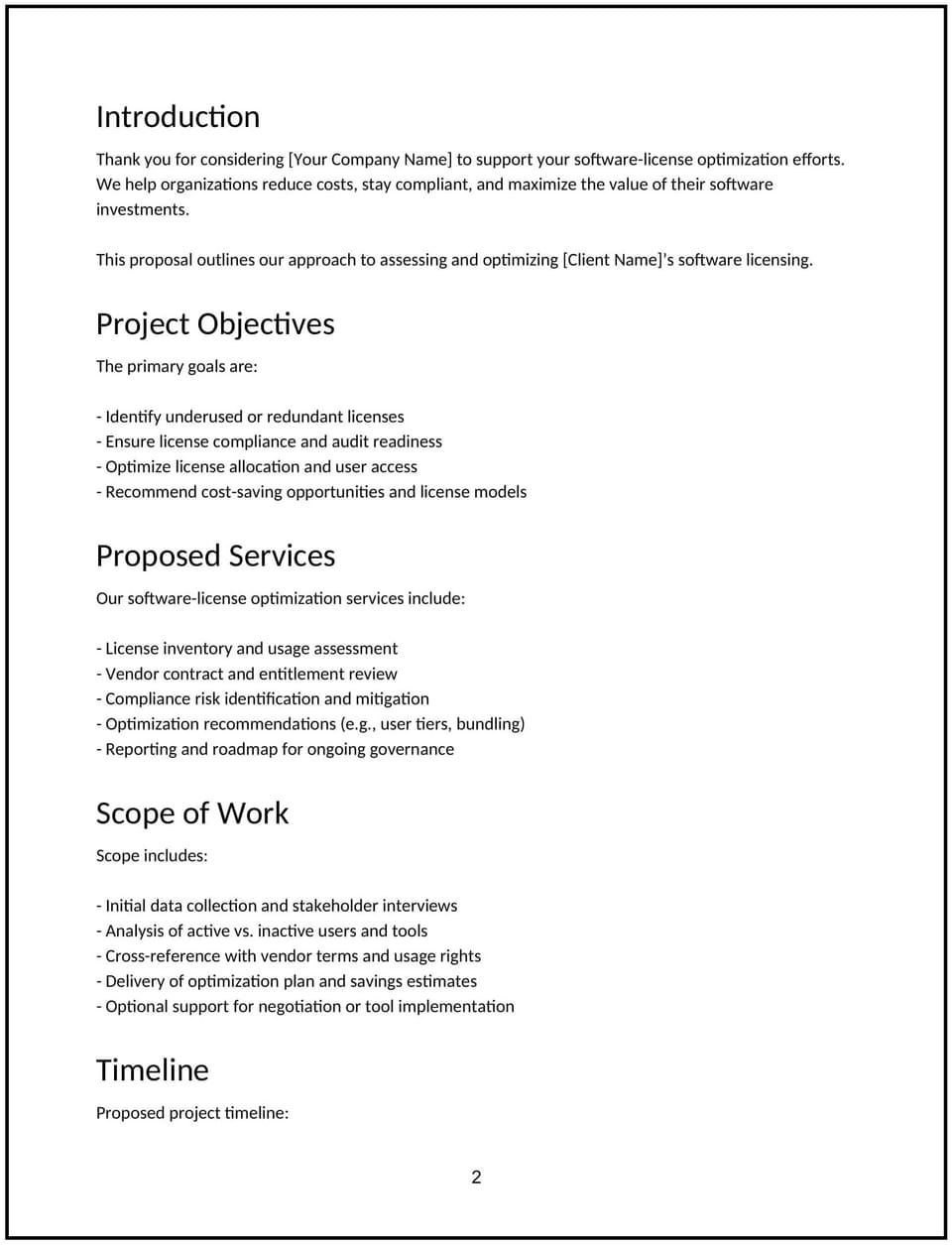Software license optimization proposal: Free template

Customize this free software license optimization proposal with Cobrief
Open this free software license optimization proposal in Cobrief and start editing it instantly using AI. You can adjust the tone, structure, and content based on the client’s tech stack, license volume, and spend thresholds. You can also use AI to review your draft — spot gaps, tighten language, and improve clarity before sending.
Once you're done, send, download, or save the proposal in one click — no formatting or setup required.
This template is fully customizable and built for real-world use — ideal for pitching optimization projects to IT managers, finance teams, procurement leads, or RevOps stakeholders. Whether the client is running Microsoft 365, Adobe, Salesforce, or dozens of SaaS tools, this version gives you a structured head start and removes the guesswork.
What is a software license optimization proposal?
A software-license optimization proposal outlines your plan to reduce waste, improve visibility, and align license usage with actual needs. It typically includes usage audits, license mapping, redundancy checks, savings projections, and cleanup execution.
This type of proposal is commonly used:
- When SaaS or software costs have grown without clear oversight
- During procurement cycles, budgeting, or vendor renewals
- Ahead of mergers, re-orgs, or IT audits
- As part of broader cost-optimization or IT rationalization projects
It helps clients cut spend, reduce tool sprawl, and ensure every license has a purpose.
A strong proposal helps you:
- Audit active and inactive software usage across teams or departments
- Identify duplicate tools, shelfware, or overprovisioned licenses
- Recommend license right-sizing, downgrade paths, or bundled alternatives
- Deliver a prioritized savings roadmap with quick wins and long-term changes
Why use Cobrief to edit your proposal
Cobrief helps you write structured, high-signal proposals fast — with smart editing tools and zero formatting hassle.
- Edit the proposal directly in your browser: Skip the doc shuffle and just focus on your scope.
- Rewrite sections with AI: Adjust tone instantly for finance leads, IT admins, or executive buyers.
- Run a one-click AI review: Let AI flag scope creep, vague deliverables, or soft ROI framing.
- Apply AI suggestions instantly: Accept edits line by line or apply them across the full proposal.
- Share or export instantly: Send your proposal via Cobrief or download a clean PDF or DOCX version.
You’ll move from outline to signed scope in less time — with sharper language and a clearer structure.
When to use this proposal
Use this software-license optimization proposal when:
- A client’s SaaS stack has grown without central oversight
- Finance is flagging rising software costs and wants clarity
- A major renewal or true-up is approaching for a high-cost vendor
- The team is downsizing or shifting usage patterns post-reorg
- You’re supporting a broader IT audit, spend review, or M&A integration
It’s especially useful when no one knows who owns what — or why half the licenses still exist.
What to include in a software license optimization proposal
Use this template to walk the client through your process — from audit to action — in clear, structured, plain-English language.
- Project overview: Frame the problem — rising costs, redundant tools, unclear ownership — and how your work aligns software with actual usage.
- Usage audit: Describe how you’ll inventory licenses, tools, and user activity — across systems like Microsoft, Google, Salesforce, Adobe, and other major vendors.
- License mapping: Map users to licenses and roles. Identify inactive accounts, overprovisioned tiers, or duplicative tools.
- Redundancy and overlap check: Compare tools by category (e.g., file storage, video calling, project management) and surface consolidation opportunities.
- Rightsizing and recommendations: Propose practical downgrades, reallocations, or terminations based on actual activity and value.
- Savings model: Estimate cost reduction by scenario — quick wins vs. contractual changes. Include ROI timeline if relevant.
- Stakeholder alignment: Show how findings can be grouped by team or department to support change management.
- Implementation support: Offer optional help to action the changes — cancel licenses, migrate users, or rewrite workflows.
- Timeline and phases: Break into phases — discovery, analysis, recommendations, rollout — with rough duration for each.
- Pricing: Offer flat-fee or time-based pricing. Include optional add-ons like reporting dashboards or implementation services.
- Next steps: End with a CTA — such as providing license data exports, booking stakeholder interviews, or kicking off the audit.
Frequently asked questions (FAQs)
What data sources do I need to request upfront?
Start with exported license lists and usage logs from major systems (e.g., Microsoft 365, Google Admin, Salesforce, Zoom). You may also need finance or procurement reports for cost data.
How do I deal with tool sprawl or unclear ownership?
Flag unassigned tools or licenses with no clear team usage. You can group these under “orphaned” spend and push to finance or IT for decisions.
How deep should I go on usage data?
Deep enough to identify clear ROI. For most tools, last login, activity volume, and role mapping are enough to right-size. Don’t overspend time on tools under $100/month unless aggregated spend is significant.
Do I recommend tool consolidation or just license reduction?
Only if scoped. You can include consolidation suggestions, but migrations or contract re-negotiations should be offered as a separate project.
What’s the risk of cutting licenses too aggressively?
Medium if visibility is weak. Offer a phased deactivation approach — e.g., downgrade first, then monitor usage before full termination.
This article contains general legal information and does not contain legal advice. Cobrief is not a law firm or a substitute for an attorney or law firm. The law is complex and changes often. For legal advice, please ask a lawyer.